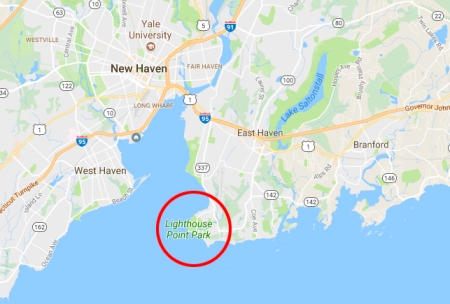A cold-front, with light N/NW winds sets up, raising the hopes that conditions over a weekend would allow me to collect some wood-warblers! But where would I go? Bluff was the obvious choice – but out of the question – I had Alex, so it had to be somewhere local. Despite a dearth of habitat, spots for consistently concentrating and holding passage warblers are few and far between in central coastal CT. Lighthouse Point it would have to be – it would be funneling birds and although birds are high, it would at least be a spot that would produce migrants. Although I didn’t have high-hopes for a lot of birds “on-the-deck”, I was about to be pleasantly surprised!
Sat 9th September
at 7am, I took up position at the NE boundary of the park. I was flanked by the harbor to the west and it overlooked the last line of trees before the park switches to a suburban development.

 It was evident that birds were moving – small incessant “chips and chups” high overhead in the azure sky, could be heard as soon as I had exited the car. The birds were coming thick and fast, foraging and then moving along the line of trees before launching themselves out over the harbor. It was evident that the sky was layered and peppered with neotropical migrants, notably American Redstarts and Blue gray Gnatcatchers – the biggest flight of that species I has ever seen. The distinctive “blink-blink” of Bobolinks formed a backdrop, moving high above the warblers and invisible to the eye.
It was evident that birds were moving – small incessant “chips and chups” high overhead in the azure sky, could be heard as soon as I had exited the car. The birds were coming thick and fast, foraging and then moving along the line of trees before launching themselves out over the harbor. It was evident that the sky was layered and peppered with neotropical migrants, notably American Redstarts and Blue gray Gnatcatchers – the biggest flight of that species I has ever seen. The distinctive “blink-blink” of Bobolinks formed a backdrop, moving high above the warblers and invisible to the eye.
I was the only birder present, so numbers are a conservative estimate and I am sure I missed more than a few things.
With similar conditions to yesterday but with lighter winds out of the north, I knew there would be birds today. I got there early and took up a position about 6:45 am, slightly more north of where I was yesterday, hoping to get a “warbler id in flight” refresher course. In the 80/90s, when I resided in Cape May, and free from the confines of a day-job, I was able to witness almost every fall cold front! However, those days are long gone for me and you quickly get out of practice. It can be humbling in conditions, like today,when birds are high and small. That is the case at Lighthouse..birds are already in the stratosphere, so pinning a name to many is tough…but sometimes you get lucky with a few. Assuming you can track these and lock focus with a camera, it provides some “after the event” clues to the dashing dot’s identity!































